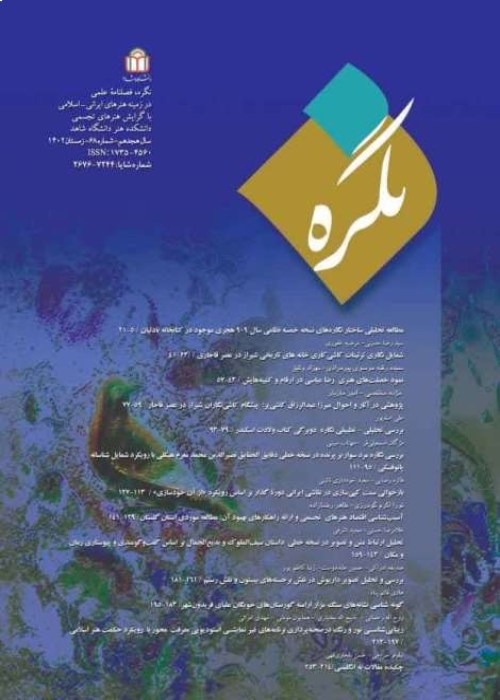Analysis of the Subject and Content of the Designs of the Safavid Period Copper Coins (Foluses) with Emphasis on the Patterns of the Lion and the Sun
Author(s):
Article Type:
Research/Original Article (دارای رتبه معتبر)
Abstract:
The various types of coins with different materials, shapes, and themes in each period are a reflection of the cultural functions of that period, and in addition to the economic function, have presented a set of ideologies of the ruling system. Coinage is one of the first obvious signs of civilization and a kind of beginning of the complex social life of the tribes. Patterns and themes engraved on coins have been a constant trend throughout history, but on the other hand in each period they would change and these changes have been influenced by the political and religious attitudes of rulers and artists who designed these coins. The coins of the Safavid period are no exception to this rule and these works have been an important platform and media for the presentation and expression of ideas and beliefs of the time, and the Safavids have used this tool well. Shiite religion, which played a key role in the formation and perpetuation of the Safavid rule, also played an important and stable role in the formation of culture and art of this era, and this area was not unaffected by the change in ideology and social developments of the time. By changing the political, military, economic, and religious structures in Iran, the Safavids achieved significant development, progress and cultural advancement. The concentration and integration of the Safavid state organization caused all the arts to flourish and many productions to be made in all fields of art, and thus the arts in this era grew significantly in quantity. The works formed during this period, backed by valuable experiences of the Timurids, had a unique strength and integrity and masterful skill that is less seen in the post-Safavid period. Shiite philosophy and thought had a special manifestation in the works of this period, to the extent that with the recognition of the Safavid Shiite dynasty in Iran, artists put more emphasis on Shiite themes as the basis of their works and used Shiite calligraphy and religious ideology in applied arts as decorative elements and tools to propagate and strengthen Shiite values. Due to the existence of two characteristic features of Shiite religion and national identity, the art of this period had become a tool for expression and was used in service of the religion. Various disciplines of art in this period were associated with Shiite thought, and symbolic language expressed the ideas of this religion. Iranian and Shiite artists reflected the spirit of Shiite thought, i.e. devotion to the family of the Prophet and the Imams, and especially Ali ibn Abi Talib (AS) himself in various ways in their works of art. This article aims to explore the hidden and less studied characteristics of copper coins or foluses of this period. Accordingly, while introducing the silver motifs on these foluses, it analyzes the motifs regarding the image of "lion and sun" as a relatively recurring theme in these works. This research with a descriptive-analytical method and historical approach, studies the content of the theme of "Lion and Sun" engraved on the common foluses of the late Safavid period, based on prefixes such as: "Content of common astronomical knowledge", "presented descriptions", “Shiite index themes in the content of narrations and hadiths" and "descriptions of Shiite index themes in literary sources", "written themes of contemporary coins" and "functional contexts of these coins". Data collection was done by library method and their analysis was qualitative. 41 folus coins minted in the Safavid period decorated with the image of lion and sun, form the samples studied in this study. The results of this study show that the designs stamped on Safavid copper coins include human (human body on horseback), cattle (horse, lion, elephant, deer, wild goat, monkey, camel, etc.), birds (with emphasis on the image of peacocks), aquatics (with emphasis on the image of fish), plants (cypress and arabesque), celestial (sun and constellations) and hybrid (peacock and snake, lion and sun, cow and fish or whale, etc.). Meanwhile, the image of "lion and sun" was one of the most frequent motifs on these copper coins. In the process of semantic analysis of this image, various contexts such as "content of common astronomical knowledge", "literary sources", "content of narrations and hadiths", "written themes of contemporary coins", "examples of paintings" and the "functional contexts of these coins" were studied, and finally, the religious and Shiite content for this image and this functional context was found more probable than other assumed contents (astronomical, ancient). According to the study of the above-mentioned texts, the content of this image is related to one of the most important principles of Shiite belief; namely the succession and guardianship of Imam Ali (AS) after the Holy Prophet of Islam (PBUH) and has a high status since it represents Imam Ali (AS) in Shiite thought.
Language:
Persian
Published:
Negareh journal, Volume:17 Issue: 62, 2022
Pages:
99 to 115
magiran.com/p2492394
دانلود و مطالعه متن این مقاله با یکی از روشهای زیر امکان پذیر است:
اشتراک شخصی
با عضویت و پرداخت آنلاین حق اشتراک یکساله به مبلغ 1,390,000ريال میتوانید 70 عنوان مطلب دانلود کنید!
اشتراک سازمانی
به کتابخانه دانشگاه یا محل کار خود پیشنهاد کنید تا اشتراک سازمانی این پایگاه را برای دسترسی نامحدود همه کاربران به متن مطالب تهیه نمایند!
توجه!
- حق عضویت دریافتی صرف حمایت از نشریات عضو و نگهداری، تکمیل و توسعه مگیران میشود.
- پرداخت حق اشتراک و دانلود مقالات اجازه بازنشر آن در سایر رسانههای چاپی و دیجیتال را به کاربر نمیدهد.
In order to view content subscription is required
Personal subscription
Subscribe magiran.com for 70 € euros via PayPal and download 70 articles during a year.
Organization subscription
Please contact us to subscribe your university or library for unlimited access!



